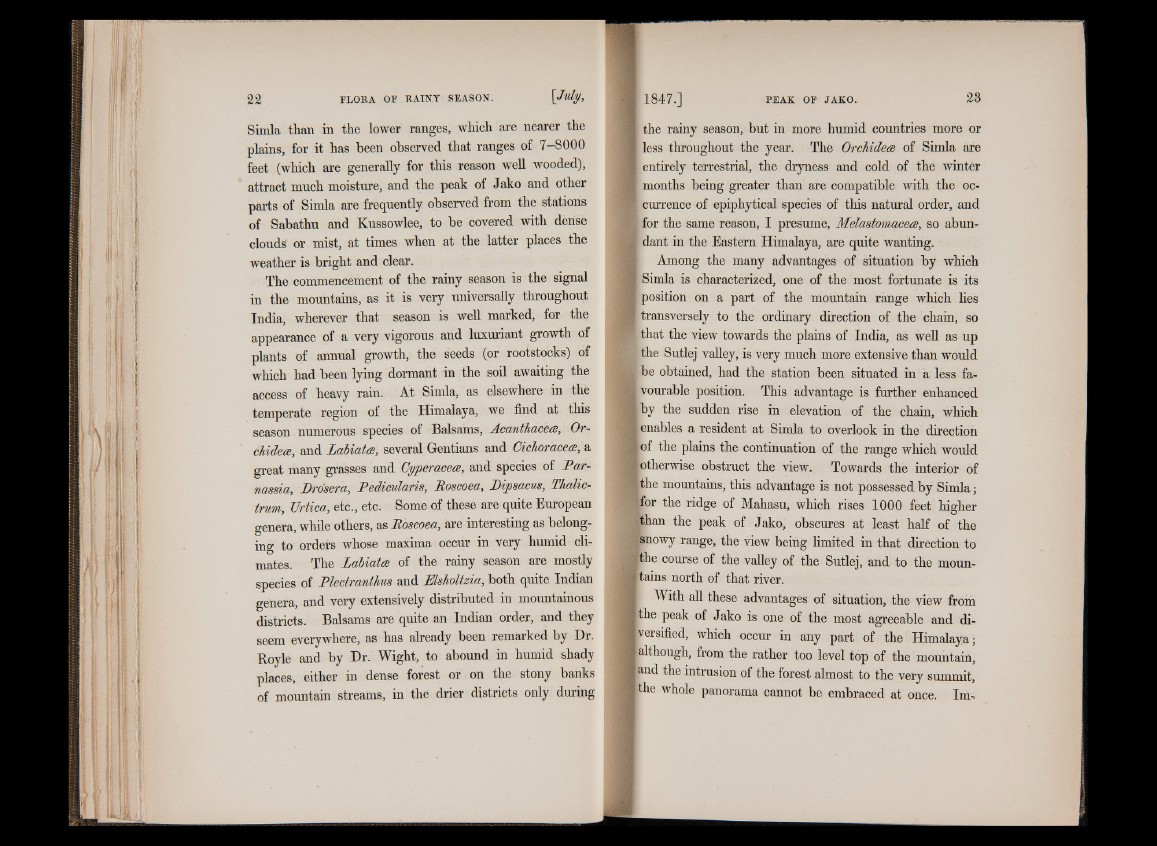
Simla than in the lower ranges, which are nearer the
plains, for it has been observed that ranges of 7-8000
feet (which are generally for this reason well wooded),
attract much moisture, and the peak of Jako and other
parts of Simla are frequently observed from the stations
of Sabathu and Kussowlee, to be covered with dense
clouds or mist, at times when at the latter places the
weather is bright and clear.
The commencement of the rainy season is the signal
in the mountains, as it is very universally throughout
India, wherever that season is well marked, for the
appearance of a very vigorous and luxuriant growth of
plants of annual growth, the seeds (or rootstocks) of
which had been lying dormant in the soil awaiting the
access of heavy rain. At Simla, as elsewhere in the
temperate region of the Himalaya, we find at this
season numerous species of Balsams, Acanthacece, Or-
chidea, and Labiates, several Gentians and Cichoracees, a
great many grasses and Cyperacees, and species of Par~
nassia, P to sg t c i, Pedicularis, Boscoea, Bipsacus, Thalic-
trum, Urtica, etc., etc. Some of these are quite European
genera, while others, as Bascoea, are interesting as belonging
to orders whose maxima occur in very humid climates.
The Labiates of the rainy season are mostly
species of PtectTavLhus and Elsholtzia, both quite Indian
genera, and very extensively distributed in mountainous
districts. Balsams are quite an Indian order, and they
seem everywhere, as has already been remarked by Dr.
Royle and by Dr. Wight, to abound in humid shady
places, either in dense forest or on the stony banks
of mountain streams, in the drier districts only during
| the rainy season, but in more humid countries more or
| less throughout the year. The Orchidece of Simla are
¡entirely terrestrial, the dryness and cold of the winter
I months being greater than are compatible with the occurrence
of epiphytical species of this natural order, and
I for the same reason, I presume, Melastomaceee, so abun-
I dant in the Eastern Himalaya, are quite wanting.
Among the many advantages of situation by which
I Simla is characterized, one of the most fortunate is its
[position on a part of the mountain range which lies
transversely to the ordinary direction of the chain, so
| that the view towards the plains of India, as well as up
the Sutlej valley, is very much more extensive than would
be obtained, had the station been situated in a less fa-
Ivourable position. This advantage is further enhanced
by the sudden rise in elevation of the chain, which
[enables a resident at Simla to overlook in the direction
of the plains the continuation of the range which would
otherwise obstruct the view. Towards the interior of
[the mountains, this advantage is not possessed by Simla;
■for the ridge of Mahasu, which rises 1000 feet higher
¡than the peak of Jako, obscures at least half of the
¡snowy range, the view being limited in that direction to
[the course of the valley of the Sutlej, and to the moun-
[tains north of that river.
With all these advantages of situation, the view from
[the peak of Jako is one of the most agreeable and diversified,
which occur in any part of the Himalaya;
¡although, from the rather too level top of the mountain,
and the intrusion of the forest almost to the very summit,
the whole panorama cannot be embraced at once. Im